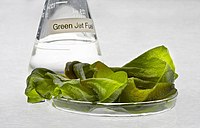
Photo from wikipedia
Microalgal biomass provides a renewable source of biofuels and other green products. However, in order to realize economically viable microalgal biorefinery, strategic identification and utilization of suitable microalgal feedstock is… Click to show full abstract
Microalgal biomass provides a renewable source of biofuels and other green products. However, in order to realize economically viable microalgal biorefinery, strategic identification and utilization of suitable microalgal feedstock is fundamental. Here, a multi-step suboptimal screening strategy was used to target promising microalgae strains from selected freshwaters of the study area. The resulting strains were found to be affiliated to seven closely-related genera of the family Scenedesmaceae, as revealed by both morphologic and molecular characterization. Following initial screening under upper psychrophilic to optimum mesophilic (irregular temperature of 14.1 to 35.9°C) cultivation conditions, superior strains were chosen for further studies. Further cultivation of the selected strains under moderate to extreme mesophilic cultivation conditions (irregular temperature of 25.7 to 42.2°C), yielded up to 74.12 mgL-1day-1, 19.96 mgL-1day-1, 48.56%, 3.34 μg/mL and 1.20 μg/mL, for biomass productivity, lipid productivity, carbohydrate content, pigments content and carotenoids content respectively. These performances were deemed promising compared with some previous, optimum conditions-based reports. Interestingly, the fatty acids profile and the high carotenoids content of the studied strains revealed possible tolerance to the stress caused by the changing suboptimal cultivation conditions. Overall, strains AY1, CM6, LY2 and KL10 were exceptional and may present sustainable, promising feedstock for utilization in large-scale generation of green products, including biodiesel, bioethanol, pigments and dietary supplements. The findings of this study, which exposed promising, eurythermal strains, would expand the current knowledge on the search for promising microalgae strains capable of performing under the largely uncontrolled large-scale cultivation settings.
Journal Title: PLoS ONE
Year Published: 2022
Link to full text (if available)
Share on Social Media: Sign Up to like & get
recommendations!